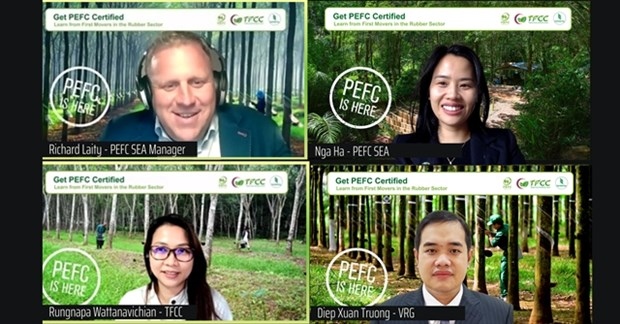Over 100,000ha of rubber plantations to get sustainable forest management certificates
More than 100,000ha of rubber plantations in Vietnam are expected to be awarded an international sustainable forest management certification by the end of this year.

Up to 38 rubber processing plants will get the Programme for the Endorsement of Forest Certification (PEFC) Chain of Custody certificate that provides independently verified assurance that the forestry-based product originates from sustainably managed forests. This certificate complements the PEFC's sustainable forest management certification, which ensures that forests are managed in line with environmental, social and economic requirements.
PEFC is the largest forest certification system in the world and the certification system of choice for small forest owners, with more than 300 million hectares represented across 49 nations. Headquartered in Geneva, Switzerland, PEFC provides independent assessment, endorsement, and recognition of national forest certification systems.
PEFC organised recently a webinar titled: "Get PEFC Certified - Learn from First Movers in the Rubber Sector", addressing common technical questions that come up during the certification process.
Joining the webinar, Diep Xuan Truong, a member of Sustainable Development Steering Committee under the Vietnam Rubber Group (VRG) said that more than 54,500ha of rubber sites, belonging to 12 member companies of VRG, and 22 rubber latex processing plants were to be recognised.
Over 60,000 tonnes of certified rubber latex and more than 300,000cu.m of rubber timber was certified by Vietnam Forest Certification Office, a member of PEFC.
Truong said that certified rubber products are welcomed in markets around the world and obtain a higher price than non-certified products.
About 1.1 million tonnes of natural rubber is produced in Vietnam yearly. 60% of the rubber is supplied by small farming households and the remaining amount is from rubber companies.
According to the General Department of Forestry, Vietnam has about one million ha of rubber plantations. Nearly 70% of rubber growing areas are generating latex. VRG, a State-owned company, is managing about 38.4% of the country’s rubber areas, households 51.9% and private companies 9.7%.
The Vietnam Forest Certification Office instructed VRG and its members to apply for the PEFC forest certification.
At the webinar, Richard Laity, PEFC Southeast Asia Manager said that natural rubber represents a US$300 billion supply chain and that natural rubber was essential material in the production of more than 40,000 types of products.
“Most of this rubber is produced by independent smallholders in Southeast Asia, on the borders of some of the world’s most ecologically important forest areas. Sourcing this rubber sustainably helps protect these forests and is a necessary step towards achieving the UN Sustainable Development Goals before 2030,” he said.
PEFC has piloted certification for both natural rubber and rubberwood across Southeast Asia. Working with growers of all sizes, PEFC has developed group certification solutions that allow smallholders to band together and prove their sustainable practices.
These early adopters demonstrate that certification is entirely achievable. By getting certified, they both open up their rubber to the market, protect adjacent forests and improve their own livelihood.
“Sustainable forest management and chain of custody certification are relatively new for the rubber industry. But early adopters are already on the move,” he said.
Successful pilot projects to certify rubber producers and rubber processors set a new standard for environmental sustainability in the rubber industry.
“Lessons learned from these early adopters have value for the entire rubber sector,” he said.
This webinar is part of the PEFC's Supporting Sustainable Rubber campaign, telling the story of both natural rubber and the people that produce it, making a connection between sustainable natural rubber production, forest health, and smallholder livelihoods.
